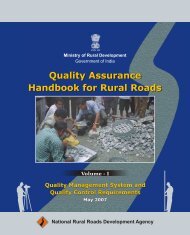Grameen Sampark Final April 0... - pmgsy
Grameen Sampark Final April 0... - pmgsy
Grameen Sampark Final April 0... - pmgsy
You also want an ePaper? Increase the reach of your titles
YUMPU automatically turns print PDFs into web optimized ePapers that Google loves.
18<br />
Subgrade Failure Criterion<br />
The basic design thickness in the case of low-volume<br />
roads is the thickness of unbound granular material,<br />
which will limit the vertical compressive strain on top of<br />
the subgrade to an acceptable level. The strain induced<br />
in the subgrade by moving wheel load is mostly elastic<br />
(recoverable). However, the accumulation of the<br />
irrecoverable part of strain leads to permanent<br />
deformation in subgrade. The permanent deformation<br />
manifests at the surface of the pavement as rutting in the<br />
wheel paths, although due to inherent variability of the<br />
subgrade and pavement materials and the construction<br />
techniques, surface roughness develops along with<br />
rutting.<br />
Performance Criteria Addopted By Different<br />
Organizations<br />
AustRoads Design for granular pavements with thin<br />
bituminous surfacing [2 3]<br />
The limiting strain criterion for the subgrade is given by<br />
Eq. 1. It was derived by applying mechanistic procedure<br />
to a range of pavements.<br />
Where,<br />
7.14<br />
N = [8511/ µ ] (1)<br />
µ <br />
<strong>Grameen</strong> <strong>Sampark</strong><br />
= vertical compressive strain (microstrain)<br />
at the top of the subgrade<br />
N = allowable number of repetitions of the<br />
strain before unacceptable level of<br />
rutting develops.<br />
Implicit in the design procedure for granular pavements<br />
with thin bituminous surfacing, is a terminal condition<br />
which is considered to be unacceptable and hence<br />
signifies the end of life of the pavement. The terminal<br />
condition is considered to be an average rut depth of<br />
about 20mm, and terminal roughness about three times<br />
the initial roughness.<br />
AASHTO Low Volume Road Design Procedure [1]<br />
The low-volume road design procedure used by<br />
AASHTO is based on lower level of reliability (50%)<br />
because of their low usage and associated low level of<br />
risk. Predicted future traffic, seasonal resilient moduli of<br />
roadbed soil, elastic modulus of aggregate base and<br />
subbase layer, design serviceability loss, allowable<br />
rutting and aggregate loss (GL) of surface course are the<br />
main input for the design of low volume roads.<br />
Common values for terminal serviceability index are<br />
Pt=2.<strong>0.</strong> For minor highways like aggregate surfaced<br />
roads, where funds or economy is the main factor, the<br />
design is done by reducing the traffic or design life rather<br />
than reducing the terminal serviceability to a number<br />
lower than 2.0<strong>0.</strong> Aggregate loss due to traffic and<br />
erosion should be considered in the design and this may<br />
be calculated using any of the following equations 2, 3<br />
and 4.<br />
According to a study by University of Texas at Austin:<br />
Where,<br />
GL = <strong>0.</strong>12 + <strong>0.</strong>1223 (LT) (2)<br />
GL = Total Aggregate loss in inches;<br />
LT = Number of loaded trucks in<br />
thousands<br />
Another study in Brazil formulated the following<br />
equation:<br />
GL = (B/25.4)/ (<strong>0.</strong>0045LADT + 338<strong>0.</strong>6/R +<br />
<strong>0.</strong>467G) (3)

















